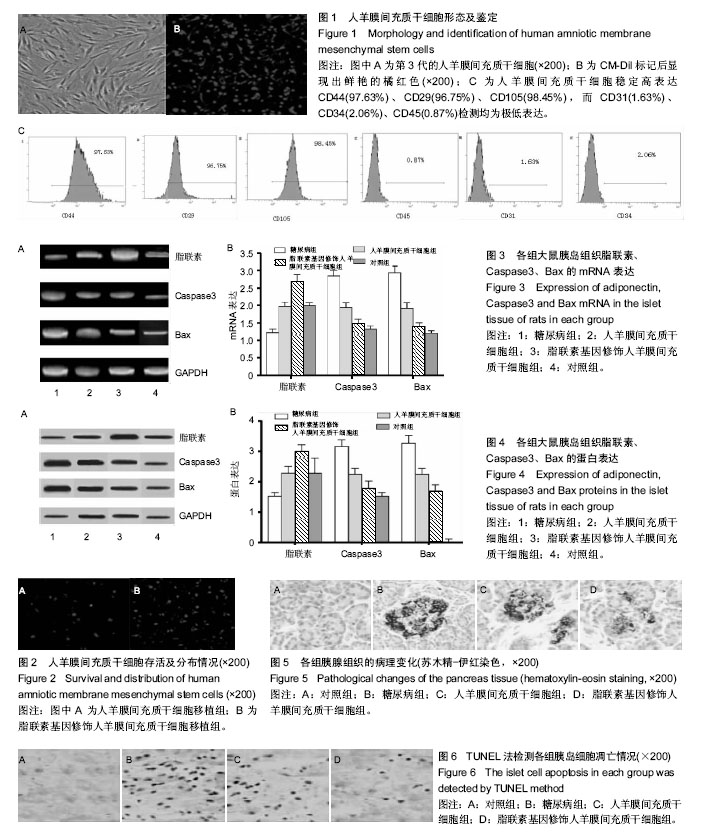| [1] 向宁飞,周智广.关于中国成人自身免疫糖尿病的首项全国性多中心研究-LADAchina研究的结果与意义[J].中华内分泌代谢杂志, 2013,29(6):443-445.[2] Barcala Tabarrozzi AE, Castro CN, Dewey RA, et al. Cell-based interventions to halt autoimmunity in type 1 diabetes mellitus. Clin Exp Immunol. 2013;171(2):135-146.[3] Haidara MA, Assiri AS, Youssef MA, et al. Differentiated mesenchymal stem cells ameliorate cardiovascular complications in diabetic rats. Cell Tissue Res. 2015;359(2):565-575.[4] Bayo P, Jou A, Stenzinger A, et al. Loss of SOX2 expression induces cell motility via vimentin up-regulation and is an unfavorable risk factor for survival of head and neck squamous cell carcinoma. Mol Oncol. 2015;9(8):1704-1719.[5] Dreyling M, Amador V, Callanan M, et al. Update on the molecular pathogenesis and targeted approaches of mantle cell lymphoma: summary of the 12th annual conference of the European Mantle Cell Lymphoma Network. Leuk Lymphoma. 2015;56(4):866-876.[6] Wang Y, Fu B, Sun X, et al. Differentially expressed microRNAs in bone marrow mesenchymal stem cell-derived microvesicles in young and older rats and their effect on tumor growth factor-β1-mediated epithelial-mesenchymal transition in HK2 cells. Stem Cell Res Ther. 2015;6:185.[7] Gabr MM, Zakaria MM, Refaie AF, et al. Insulin-producing cells from adult human bone marrow mesenchymal stem cells control streptozotocin-induced diabetes in nude mice. Cell Transplant. 2013;22(1):133-145.[8] Strioga M, Viswanathan S, Darinskas A, et al. Same or not the same? Comparison of adipose tissue-derived versus bone marrow-derived mesenchymal stem and stromal cells. Stem Cells Dev. 2012;21(14):2724-2752.[9] Fischerová D, Zikán M, Pinkavová I, et al. The rational preoperative diagnosis of ovarian tumors - imaging techniques and tumor biomarkers (review).Ceska Gynekol. 2012;77(4):272-287.[10] Mauro L, Pellegrino M, Giordano F, et al. Estrogen receptor-α drives adiponectin effects on cyclin D1 expression in breast cancer cells.FASEB J. 2015;29(5):2150-2160.[11] Xia ZX, Li ZX, Zhang M, et al. CARMA3 regulates the invasion, migration, and apoptosis of non-small cell lung cancer cells by activating NF-кB and suppressing the P38 MAPK signaling pathway. Exp Mol Pathol. 2016;100(2): 353-360.[12] Fischerová D, Zikán M, Pinkavová I, et al. The rational preoperative diagnosis of ovarian tumors - imaging techniques and tumor biomarkers (review). Ceska Gynekol. 2012;77(4):272-287.[13] 张弛,肖日军,张娜,等.脐血干细胞移植治疗糖尿病大鼠下肢缺血的实验研究[J].中华损伤与修复杂志,2012,7(1):12-16.[14] Griffin TP, Martin WP, Islam N, et al. The Promise of Mesenchymal Stem Cell Therapy for Diabetic Kidney Disease. Curr Diab Rep. 2016;16(5):42.[15] Fang Y, Tian X, Bai S, et al. Autologous transplantation of adipose-derived mesenchymal stem cells ameliorates streptozotocin-induced diabetic nephropathy in rats by inhibiting oxidative stress, pro-inflammatory cytokines and the p38 MAPK signaling pathway. Int J Mol Med. 2012;30(1): 85-92.[16] Tahir H, Wani A, Daruwalla V, et al. Euglycemic diabetic ketoacidosis and severe acute kidney injury secondary to off label use of sodium glucose cotransporter-2 inhibitor in a type-1 diabetic patient. J Ayub Med Coll Abbottabad. 2015; 27(4):923-924.[17] Koh GY, Derscheid R, Fuller KN, et al. Circulating adiponectin concentrations are increased by dietary resistant starch and correlate with serum 25-hydroxycholecalciferol concentrations and kidney function in Zucker diabetic fatty rats. Nutr Res. 2016;36(4):311-319.[18] Buehrer BM, Cheatham B. Isolation and characterization of human adipose-derived stem cells for use in tissue engineering. Methods Mol Biol. 2013;1001:1-11.[19] Agorogiannis GI, Alexaki VI, Castana O, et al. Topical application of autologous adipose-derived mesenchymal stem cells (MSCs) for persistent sterile corneal epithelial defect. Graefes Arch Clin Exp Ophthalmol. 2012;250(3):455-457.[20] Ding DC, Chou HL, Hung WT, et al. Human adipose-derived stem cells cultured in keratinocyte serum free medium: Donor's age does not affect the proliferation and differentiation capacities. J Biomed Sci. 2013;20:59.[21] Ying C, Hu W, Cheng B, et al. Neural differentiation of rat adipose-derived stem cells in vitro. Cell Mol Neurobiol. 2012;32(8):1255-1263.[22] 赵林华,姬航宇,冀博文,等.葛根芩连汤治疗糖尿病理论探讨[J].中华中医药杂志,2012,27(2):280-283.[23] 蒲莹峰,方宁,陈代雄,等.人羊膜问充质干细胞对大鼠1型糖尿病模型的疗效及免疫调节作用[J].中华内分泌代谢杂志,2014, 30(1):55-60.[24] 毛家玺,汤晓静.干细胞在急性胰岛损伤中的治疗作用及进展[J].中国中西医结合胰岛病杂志,2012,13(1):86-88. |
.jpg)


.jpg)